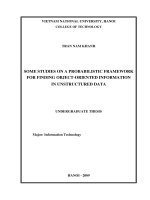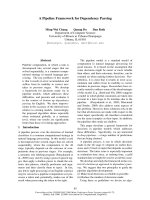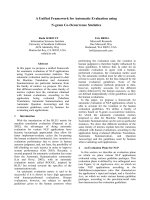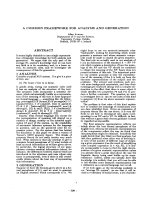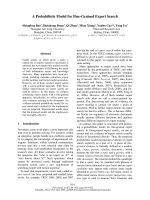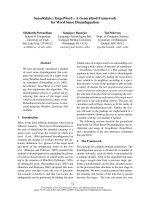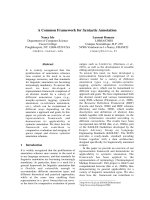Some studies on a probabilistic framework for finding object-oriented information in unstructured data
Bạn đang xem bản rút gọn của tài liệu. Xem và tải ngay bản đầy đủ của tài liệu tại đây (713.73 KB, 51 trang )
VIETNAM NATIONAL UNIVERSITY, HANOI
COLLEGE OF TECHNOLOGY
TRAN NAM KHANH
SOME STUDIES ON A PROBABILISTIC FRAMEWORK
FOR FINDING OBJECT-ORIENTED INFORMATION
IN UNSTRUCTURED DATA
UNDERGRADUATE THESIS
Major: Information Technology
HANOI - 2009
VIETNAM NATIONAL UNIVERSITY, HANOI
COLLEGE OF TECHNOLOGY
TRAN NAM KHANH
SOME STUDIES ON A PROBABILISTIC FRAMEWORK
FOR FINDING OBJECT-ORIENTED INFORMATION
IN UNSTRUCTURED DATA
UNDERGRADUATE THESIS
Major: Information Technology
Supervisor: Assoc. Prof. Dr. Ha Quang Thuy
Co-supervisor: MSc. Nguyen Thu Trang
HANOI - 2009
i
ABSTRACT
With the rise of the Internet, there is more and more information available on the
web. Among this, there is a lot of structured data embedded within web pages such as
“an apartment with location, property type, price, bedrooms, bathrooms, area,
direction”, etc...
However, there lacks an efficient method to retrieval those information.
Therefore, in the two recent years, object search has been proposed and interested in as
search method for domain-specific Internet application. To deal with the problem,
some approaches have also researched such as Information Extraction, Text
Information Retrieval. Yet, these approaches have faced with the challenges about
scalability and adaptability.
The thesis studies a novel machine learning framework to solve the object search
problem and evaluate this approach to a Vietnamese domain - real estate. It shows a
significant improvement in accuracy over the current retrieval method - the Mean
Average Precision and Mean Reciprocal Rank of the approach is much better than
those of baseline one, retrieve objects effectively and adapt to new domain easily. By
developing from the idea, we also propose a method to generate snippet which helps
users to identify the information they need without referring to document text. This
method is also implemented and integrated successfully into object search systems -
professor homepages search, camera product search.
ii
ACKNOWLEDGMENTS
Conducting this first thesis has taught me a lot about beginning scientific
research. Not only the knowledge, more importantly, it has encouraged me to step
forward on this challenging area.
Firstly, I would like give my deepest thank to my research advisor, Prof. Dr. Ha
Quang Thuy, who offers me an endless inspiration in scientific research, leading me to
this research area. It is one of my biggest opportunities which have directed me to this
way in higher education.
I would like to give my gratitude to MSc. Nguyen Thu Trang who has instructed
me carefully and enthusiastically. She has given to me many advices and comments.
This work can not be possible without her support.
I also want to thank Mr. Kim Cuong Pham, PhD candidate at University of
Illinois at Urbana-Chanpaign, who lets me a big opportunity work together with him
for this work. He has encourages me a lot to finish this thesis.
Many thanks also go to all members of seminar group “data mining” who gave
me motivation and pleasure during the time.
Finally, from bottom of my heart, I would specially like to say thanks to my
family, my parents, my sister and all my friends.
iii
TABLE OF CONTENTS
Introduction ................................................................................................................... 1
Chapter 1. Object Search .............................................................................................. 3
1.1
Web-page Search ............................................................................................... 3
1.1.1
Problem definitions ..................................................................................... 3
1.1.2
Architecture of search engine...................................................................... 4
1.1.3
Disadvantages ............................................................................................. 6
1.2
Object-level search ............................................................................................. 6
1.2.1
Two motivating scenarios ........................................................................... 6
1.2.2
Challenges ................................................................................................... 8
1.3
Main contribution ............................................................................................... 8
1.4
Chapter summary ............................................................................................... 9
Chapter 2. Current state of the previous work ......................................................... 10
2.1
Information Extraction Systems ...................................................................... 10
2.1.1
System architecture ................................................................................... 10
2.1.2
Disadvantages ........................................................................................... 11
2.2
Text Information Retrieval Systems ................................................................ 12
2.2.1
Methodology ............................................................................................. 12
2.2.2
Disadvantages ........................................................................................... 12
2.3
A probabilistic framework for finding object-oriented information in
unstructured data........................................................................................................ 13
2.3.1
Problem definitions ................................................................................... 13
2.3.2
The probabilistic framework ..................................................................... 14
2.3.3
Object search architecture ......................................................................... 17
2.4
Chapter summary ............................................................................................. 19
Chapter 3. Feature-based snippet generation ........................................................... 21
3.1
Problem statement ............................................................................................ 21
3.2
Previous work .................................................................................................. 22
3.3
Feature-based snippet generation ..................................................................... 23
3.4
Chapter summary ............................................................................................. 25
Chapter 4. Adapting object search to Vietnamese real estate domain ................... 26
4.1
An overview ..................................................................................................... 26
iv
4.2
A special domain - real estate .......................................................................... 27
4.3
Adapting probabilistic framework to Vietnamese real estate domain ............. 29
4.3.1
Real estate domain features ....................................................................... 29
4.3.2
Learning with Logistic Regression ........................................................... 31
4.4
Chapter summary ............................................................................................. 31
Chapter 5. Experiment ................................................................................................ 32
5.1
Resources ......................................................................................................... 32
5.1.1
Experimental Data ..................................................................................... 32
5.1.2
Experimental Tools ................................................................................... 33
5.1.3
Prototype System ...................................................................................... 33
5.2
Results and evaluation ..................................................................................... 33
5.3
Discussion ........................................................................................................ 36
5.4
Chapter summary ............................................................................................. 37
Chapter 6. Conclusions ............................................................................................... 38
6.1
Achievements and Remaining Issues .............................................................. 38
6.2
Future Work ..................................................................................................... 38
v
LIST OF FIGURES
Figure 1. Web page graph ........................................................................................... 3
Figure 2. Example of web-page search ....................................................................... 4
Figure 3. General Architecture of Search Engine ....................................................... 5
Figure 4. Professor homepage search .......................................................................... 7
Figure 5. Real estate search ......................................................................................... 7
Figure 7. Examples of customizing Google Search engine ......................................... 12
Figure 8: Feature Execution on Inverted List .............................................................. 17
Figure 9. Object Search Architecture .......................................................................... 18
Figure 10. Examples of snippet ................................................................................... 21
Figure 11. Feature-based snippet framework .............................................................. 23
Figure 12. Example of feature-based snippet .............................................................. 25
Figure 13. Some search engines in Vietnam ............................................................... 26
Figure 14. Two example websites about real estate .................................................... 27
Figure 15. Search interface on real estate websites ..................................................... 28
Figure 16. Apartment search of Cazoodle ................................................................... 28
Figure 17. Camera product search ............................................................................... 29
Figure 18. Precision for Real Estate Search Engine .................................................... 35
Figure 19. Average Precision of comparison between BM25 and OS ........................ 36
vi
LIST OF TABLES
Table 1. Web pages search problem ............................................................................ 4
Table 2. Object search problem definition .................................................................. 13
Table 3. List of Operators and their functionality ....................................................... 16
Table 4. List of features used in real estate domain in Vietnamese ............................ 30
Table 5. Testing data for real estate domain ............................................................... 32
Table 6. Real estate queries for testing ........................................................................ 34
Table 7. Comparison MAP and MRR of BM25 and OS ............................................. 35
vii
LIST OF ABBRREVIATIONS
HTML HyperText Markup Language
IE Information Extraction
IR Information Retrieval
MAP Mean Average Precision
MRR Mean Reciprocal Rank
OS Object Search
SQL Structured Query Language
URL Uniform Resource Locator
1
Introduction
The Internet has become important in daily life and as a result, Internet search
has never played a more significant role. It is crucial for Internet users to obtain the
desired information in an efficient and direct manner.
Currently, there is a lot of information available in structured format on the web.
For example, an apartment on real estate website usually has its structured information
such as location, number of bedrooms, price and area. A professor homepage usually
contains information about his education, email, department and the university that he
is in. These are examples of structured information that is exuberant on the web. From
the object oriented perspective, considering each of above domains as a class of
objects, a web page containing detailed structured information as an object with its
attributes. The problem of finding structured information on the web becomes object
retrieval problem. Unfortunately, the current information retrieval approaches can not
handle object search effectively.
Therefore, in recent two years, the problem is being interested by many scientists
and researchers [7][13][14][20][27] They have proposed some approaches of
overcoming the shortcoming of this current search engine for finding object on the
web.
The thesis presents an investigation into the problem of searching for object,
plausible solutions related to the problem. In particular, the main objectives of the
thesis are:
- To give insight into object search problem, its motivation, some well-known
object search systems and define the challenges which are required for these
systems.
- To investigate the plausible solutions with literature techniques which have
been published recently to solve the problem, especially study in-detail a novel
machine learning framework [13].
- To propose a new approach to generate snippet for object search engine.
- To adapt object search to Vietnamese Real Estate domain and evaluate the
performance of the approach through a number of experiments.
Roadmap: The organization of this thesis is follow
2
Chapter 1 provides a general overview of object search, its motivation
comparing to the current search engine through some examples. This chapter then
describes the challenges which they had faced with.
Chapter 2 presents the current state of previous work of searching for object
with focus on the probabilistic framework for finding object-oriented information in
unstructured data. This chapter also gives their advantages and shortcoming in solving
object search problem.
Chapter 3 introduces our general framework for generating snippet based on
feature language, index and document, then explains main advantages of the
framework.
Chapter 4 investigates the object search problem in Vietnam. We first review
the structure information on the Vietnamese websites with focus on Real Estate
domain. We then describe our adapting the probabilistic framework to Vietnamese
Real Estate domain.
Chapter 5 presents our experiments on real estate domain to evaluate the
performance of the probabilistic framework and discuss the results.
Chapter 6 sums up the main contribution, achievements, remaining issues and
future work.
3
Chapter 1. Object Search
Current web search engines essentially conduct document-level ranking and
retrieval. However, structured information about real-world objects embedded in static
web pages and online databases exists in huge amounts. Typical objects are products,
people, papers, organizations, and the like. Document-level information retrieval can
unfortunately lead to highly inaccurate relevance ranking in answering object-oriented
queries.
This chapter gives an insight into document-level information retrieval (web-
page search), its shortcoming, as a result, motivating to object-level search. In the
second section, we focus on object search, its concepts and some examples of real-
world. We then give the challenges to the research community in the field and some
conclusions.
1.1 Web-page Search
1.1.1 Problem definitions
The Internet can be considered a collection of web pages P, with link structure
included in the web-page document. Thus, we have that P = {d
1
, d
2
, … , d
n
} where d
i
is a web-page document.
Figure 1. Web page graph
The query Q is a set of keywords which describe what the user wants to find out.
Hence, we have Q = {k
1
, k
2
, … , k
m
} where k
j
is a single keyword.
The output for web-page search approach is a list of web pages that contains
query keywords ordered by the rank of the page. The rank typically expresses the
quality of the web page related to the query. We assume that the result R = {p
1
, p
2
, … ,
p
k
} where p
l
is a returned web page.
A
B
C
D
E
F
4
Therefore, the user should go through each page for determining whether the
page contains information that he needs or not. To sum up, we model the web-page
search problem as the table 1.
Table 1. Web pages search problem
Given: A collection P of web pages with link structure
Input: Keywords query Q = {k
1
, k
2
, … , k
m
}
Output: Ranked list of pages R
The figure 2 shows an example of the web-page search with document-level
information retrieval approach on Google search engine.
Figure 2. Example of web-page search
1.1.2 Architecture of search engine
The general architecture of a web retrieval system (usually called Search Engine)
is shown in the figure 3 [23]. The architecture contains all the major elements of a
traditional retrieval system. There are also, in addition to these elements, two more
components. One is the World Wide Web itself. The other is the Crawler which is a
module that crawls web pages from the Web.
5
Figure 3. General Architecture of Search Engine
Each module in architecture of search engine has its own role.
• Crawler module: Walking on the Web, from page to page, download them and
send them to the Repository.
• Repository: Storing the Web pages downloaded by Crawler module.
• Indexing module: The Web pages from Repository are processed by the
programs of the Indexing module (HTML tags are filtered, terms are extracted,
etc..)
• Indexes: This component of the search engine is logically organized as an
inverted file structure.
• Query module: It reads in what the user has typed into the query line and
analyzes and transforms it into an appropriate format.
• Ranking module: The pages sent by the Query module are ranked (sorted in
descending order) according to a similarity score. It is presented to the user on
the computer screen in the form of a list of URLs together with a snippet.
CRAWLER MODULE
REPOSITORY
INDEXING MODULE
INDEXES
QUERY MODULE
RANKING MODULE
6
1.1.3 Disadvantages
First, from page view of the Web, it is obvious that it is very hard for users to
describe directly what they want. They have to formulate their needs indirectly as
keyword queries, often in a non-trivial and non-intuitive way with a hope for getting
“relevant pages” that may or may not contain target objects [20].
Second, users can not directly get what they want. The search engine only return
a list of pages related to query ordered by ranking. Therefore, they have to scrutinize
them to find out which pages they need. When the users have to examine each page for
determine whether or not this page is their need, they will not feel comfortable.
1.2 Object-level search
As mentioned above, the good search engine has to be easy to use, however
return what users want to get. Currently, Google is the most popular search engine to
users in search technology. However, it also has some constraints for finding
information about objects in some specific domains like person, product, etc…
In two recent years, many scientists have researched and proposed approaches to
deal with the object search problem [7][13][14][20][27]. The section focuses on
studying this problem: motivation, basic concepts, and challenges.
1.2.1 Two motivating scenarios
• Professor home page search
In this scenario, Ruby wants to look for the homepage of professors who are
teaching at Illinois University and working in “databases” area. Firstly, she goes to
Google and types “professor Illinois database”. However, Google returned her with list
of pages related to the query. Some are homepages, some are publications and some
are just news. She may have to look through each page to find out which pages she
needs. Moreover, some professors in “biology” may be ranked higher than some
“databases” professors and some professor’s homepages are ranked lower than some
news article about themselves. All things make Ruby confused and turned to object
search engine.
The system lets her enter the information into necessary field while leaving other
field such as “name” blank. As soon as, Ruby hits “Search” button, the system returns
the list of homepages ranked by the relevance to her query. She realized the top ranked
result satisfies all of her constraints. Therefore, Ruby can have some ideas about
returned objects without opening the links.
7
Figure 4. Professor homepage search
• Real estate search
In this scenario, Lien is looking for an apartment to buy. She wants an apartment
in Ba Dinh, Hanoi, used area from 100 m2 to 500 m2 and price not over 1 billion VND.
It is very difficult to find an apartment which satisfies these constraints with current
search engine: Google, Yahoo. Therefore, she will turn to object search engine with
hope for finding a satisfied one.
The figure 5 provides an interface example for the problem of searching for an
apartment.
Figure 5. Real estate search
8
1.2.2 Challenges
For object search problem, there are some requirements for a large-scale object-
level vertical search engine.
• Reliability
High quality structured data is necessary to generate direct and aggregate
answers. If the underlying data are not reliable, then the users may prefer sifting the
web pages to find answers rather than trust the noisy direct answers returned by an
object-level vertical search engine [26][27].
• Ranking Accuracy
With billions of potential answers to a query, an optimal ranking mechanism is
critical for locating relevant object information from web pages [26][27].
• Scalability
The size of the web gives rise to the requirement of scalability. If the size of the
web is small, one can use a lot of different solutions. The large volume of web pages
on the web makes the problem challenging. Furthermore, some information on the web
is also changing such as price, etc…, the solutions should be ale to handle a large
number of the web pages in which some portion might change frequently [13].
• Adaptability
There is no standard on how websites have to be, except the HTML standard. In
addition, many new websites are added and old ones are deleted every day. Thus, if a
system can not adapt to change, it might get obsolete and not usable at all [13].
1.3 Main contribution
Bearing in mind the importance of searching information on the Web, studies
have shown that current search engine is not suitable for finding object in a specific
domain on the Internet. It is necessary to build an object search engine to deal with the
problem.
The thesis investigated the object search problem and some plausible solutions in
which we focus on a probabilistic framework for finding object-oriented information
in unstructured data [13] [14].
To deal with this problem more efficient, we have proposed an approach for
generating snippet for this system using feature language, index-based and document-
9
based. We also adapt the probabilistic framework to Vietnamese Real Estate domain
and have a satisfactory result.
1.4 Chapter summary
This chapter brought an overview of web-page problem and its disadvantages, as
a result, motivating into object search problem in general and some specific
domains in particular. After introducing some examples of searching for object which
let users turn to object search engine, we then introduced the challenges which current
approaches need to overcome in section 1.2.2. We then summarize our main
contribution through out this thesis.
10
Chapter 2. Current state of the previous work
We have introduced about the object search problem which have been interested
in by many scientists. In this chapter, we discuss plausible solutions, which have been
proposed recently with focus on the novel machine learning framework to solve the
problem.
2.1 Information Extraction Systems
One of the first solutions in object search problem is based on Information
Extraction System. After fetching web data related to the targeted objects within a
specific vertical domain, a specific entity extractor is built to extract objects from web
data. At the same time, information about the same object is aggregated from multiple
different data resources. Once object are extracted and aggregated, they are put into
the object warehouses and vertical search engines can be constructed based-on the
object-warehouses [26][27]. Two famous search engines have built related to this
approach: Scientific search engine - Libra (), Product search engine
- Window Live Product Search (). In Vietnam, Cazoodle
company, which professor Kevin Chuan Chang has supported, is also developing
under the approach ().
2.1.1 System architecture
2.1.1.1 Object-level Information Extraction
The task of an object extractor is to extract metadata about a given type of
objects from every web page containing this type of objects. For example, for each
crawled product page, the system extracts name, image, price and description of each
product.
However, how to extract object information from web pages generated by many
different templates is non-trivial. One possible solution is that we first distinguish web
pages generated by different templates, and then build an extractor for each template
(template-dependent). Yet, this one is not realizable. Therefore, Zaiqing Nie has
proposed template-independent metadata extraction techniques [26][27] for the same
type of objects by extending the linear-chain Conditional Random Fields (CRFs).
2.1.1.2 Object Aggregator
Each extracted web object need to be mapped to a real world object and stored
into a web data warehouse. Hence, the object aggregator needs to integrate information
about the same object and disambiguate different objects.
11
Figure 6. System architecture of Object Search based on IE
2.1.1.3 Object retrieval
After information extraction and integration, the system should provide retrieval
mechanism to satisfy user’s information needs. Basically, the retrieval should be
conducted at the object level, which means that the extracted objects should be
indexed and ranked against user queries.
To be more efficient in returning result, the system should have a more powerful
ranking model than current technologies. Zaiqing Nie has proposed the PopRank
model [28], a method to measure the popularity of web objects in an object graph.
2.1.2 Disadvantages
As discussed above, one of obvious advantages is that once object information is
extracted and stored in warehouse, it can be retrieved effectively by a SQL query or
some new technologies.
However, to extract object from web pages, it is usually labor intensive and
expensive techniques (e.g: HTML rendering). Therefore, it is not only difficult to scale
to the size of the web, but also not adaptable because of different formats. Moreover,
Crawler
Classifier
Paper Extractor Author Extractor Product Extractor
Paper Aggregator Author Aggregator Product Aggregator
Scientific Web
Object Warehouse
Product Web
Object Warehouse
Pop rank Object Relevance Object Categorization
12
whenever new websites are presented in totally new format, it is impossible to extract
objects without writing new IE module.
2.2 Text Information Retrieval Systems
2.2.1 Methodology
Another method for solving object search problem is that we can adapt existing
text search engines like Google, Yahoo, Live Search. Almost of current search engines
provide for users a function called advanced search which let them find out
information that they need more exactly.
We can customize search engine in many ways for targeting domain. For
example, one can restrict the list of returned sites such as “.edu” sites to search for
professor homepages. Another way is to add some keywords, such as “real estate,
price” to original queries to “bias” the search result toward real estate search.
Figure 7. Examples of customizing Google Search engine
2.2.2 Disadvantages
The advantage of using this approach is scalability because indexing text is very
fast. In addition, text can be retrieved using inverted indices efficiently. Therefore, text
retrieval systems scale well with the size of the web.
However, these approaches are not adaptable. In the above examples, the
restriction sites or “bias” keywords must be input manually. Each domain has own its
“bias” keywords and in many cases, such customizations are not enough to target to
the domain. Therefore, it is hard to adapt to the new domain or changes on the web.
13
2.3 A probabilistic framework for finding object-oriented information in
unstructured data
Two above solutions can be plausible for solving object search problem. Yet, the
Information Extraction based solution has low scalability and low adaptability while
Text Information Retrieval based solution has high scalability but low adaptability. As
a result, another approach has been proposed called probabilistic framework for
finding object-oriented information in unstructured data which is presented in [13].
2.3.1 Problem definitions
Definition 1: An object is defined by 3 tuples of length n, where n is the number
of attributes, N, V, T. N = (α
1
, α
2
.. α
n
) are the names of attributes. V = (β
1
, β
2
.. β
n
) are
the attribute values. T = (µ
1
, µ
2
.. µ
n
)
are the types that each attribute value can take in
which µ
i
often is of {number, text}.
Example 1: “An apartment in Hanoi with used area 100m2, 2 bedrooms, 2
bathrooms, East direction, 500 million VND” is defined as N = (location, types, area,
bedrooms, bathrooms, direction, price) and V = (‘Hanoi’, ‘apartment’, 100, 2, 2, ‘East’,
500) and T = (text, text, number, number, number, text, number).
Definition 2: An object query is defined by a conjunction of n attribute
constraint Q = (c
1
^ c
2
^ … ^ c
n
). Some constraints would be constant 1 when the user
does not care about the attributes. Each constraint depends on the type of attribute the
object has. A numeric attribute can have a range constraint and a text attribute can be
either a term or a phrase.
Example 2: An object query for “an apartment in Cau Giay at least 100 m2 and
at most 1 billion VND” is defined as Q = (loca=Cau giay ^ type=apartment ^ price<=
1 billion VND ^ 1 ^ 1 ^ areas>100 ^ 1). The query means the user does not care about
“bedrooms”, “bathrooms”, “direction”.
Another way of looking at our object search problem from the traditional
database perspective is to support the select query for objects on the web.
Table 2. Object search problem definition
Given: Index of the web W, An object Domain D
n
Input: Object query (Q = c
1
^ c
2
^ … ^ c
n
)
Output: Ranked list of pages in W
14
To sum up, we imagine object search problem as advanced retrieval database.
SELECT web_pages
FROM the_web
WHERE Q = c
1
^ c
2
^ … ^ c
n
is true
ORDER BY probability_of_relevance
2.3.2 The probabilistic framework
• Object Ranking
Instead of extracting object from web pages, the system returns a ranked list of
web pages that contain object users are looking for. In this framework, ranking is
based on the probability of relevance of a given object query and a document
P(relevant | object_query, document). Assuming that object query is a conjunction of
several constraints for each attributes of object and these constraints are independent,
the probability of the whole query can be computed from the probability of individual
constraint.
P (q) = P (c
1
^ c
2
^ … ^ c
n
)
= P (c
1
) P (c
2
)…P (c
n
) (1)
To calculate the individual probability P(c
i
), the approach uses machine learning
to estimate it with P
ml
(s|x
i
) where x
i
=x
i
1
,x
i
2
…x
i
k
is the relevance features between
constraint c
i
and the document.
P (c
i
) = P (c
i
| correct) x P (correct) + P (c
i
| incorrect) x P (incorrect).
= P
ml
(s | x
i
) x (1-
ε
) + 0.5 *
ε
.
(2)
ε
is an error of machine learning algorithm. If machine learning is wrong, the
best guess for P(c
i
) is 0.5.
• Learning with logistic regression
The next task of the framework is how to calculate P
ml
(s|x
i
) by machine learning.
To do this, the approach uses Logistic Regression [21] because it not only learns a
linear classifier but also has a probabilistic interpretation of the result.
Logistic Regression is an approach to learning functions of the form f: X → Y, or
P (Y | X) in the case where Y is discrete-valued, and X = <X
1
… X
n
> is any vector
containing discrete or continuous variables. In this framework, X is the feature vector
derived from a document with respected to a constraint in user object query. X
15
contains both discrete values, such as whether there is a term ‘xyz’, and continuous
values, such as normalized TF score. Y is a Boolean variable corresponding to whether
the document satisfies the constraint or not.
Logistic Regression assumes a parametric form for the distribution P (Y|X),
then directly estimates its parameters from the training data. The parametric model
assumed by Logistic Regression in the case where Y is Boolean is
and
The above probability is used for the outcome (whether a document satisfies a
constraint) given the input (a feature vector derived from the document and the
constraint).
• High level feature formulation
Another important part of this system is how to formulate k-feature vectors x
i
=
x
i
1
x
i
2
…x
i
k
from the constraint c
i
and a document. To carry out this, a list desired
features is defined [13].
- Regular expression matching features (REMF)
Because a lot of entities such as phone number (e.g: +84984 340 709), areas (e.g:
100m2)… can be represented by regular expression, the features “where such regular
expression existed” should be used.
- Constraint satisfaction features (CSF)
Since the object queries contain constraints on each attribute value, it is desired
to have features expressing whether the value found in a document is satisfied by the
constraints.
- Relational constraint satisfaction features (RCSF)
This type of feature specifies the relational constraints such as “proximity”,
“right before/after”…between the two features.
16
- Aggregate document features (ADF)
All of the above features are binary. This feature shows the way to aggregate
them for a document. For instance, count how many CSF in a document, relevant
scores of document and query such as TF-IDF, etc…
• Feature language
All features are executed based on inverted index. Therefore, the system gives a
language called the feature language to provide capability of executing efficiently on
the inverted index. The feature language is a simple tree notation that specifies a
feature exactly the way it is executed in inverted index. Each feature has a syntax:
Feature = OperatorName ( child
1
, child
2
, ….,child
n
).
Each child is an inverted list and the OperatorName specifies how the children
are merged together. The child of a feature node can either be another feature node or
a literal (text or number). The feature query, which consists of many features, forms a
forest.
Table 3. List of Operators and their functionality
Operator Description
Leaf Node Operators
Token(tok) Inverted list for term tok in Body field
HTMLTitle(tok) Inverted list for term tok in Title field
Number_body(C) Inverted list for numbers filtered by constraint C
Merging operators
And(A,B,C,…) Merge-join child lists by docid
Or(A,B,C…) Merge-join child lists
Phrase(A,B,C…) Merge-join child lists as consecutive phrase
Proximity(A,B,l,u) Merge lists A and B and join them on “position
distance [l,u]”
Arithmetic Operators
TF(A) Inverted term frequency A
